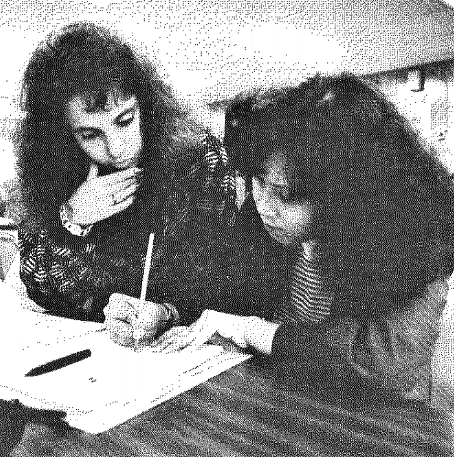
Bridging Two Worlds Through the Eastside Project
Santa Clara student Wendy Traiger (left) helps a student learning English as a Second Language at Overfelt Adult Center.
“The Project is built around a widely supported but badly neglected research finding that attitudes--personal and institutional--are more effectively changed by experience than by position papers or forceful rhetoric.’
-Stephen Privett, S.J.
Not all Santa Clara classrooms are on campus and not all teachers are faculty members. Through The Eastside Project, students, faculty and staff learn lessons that textbooks merely approach.
Designed to bridge the gap between the campus and the experience of diverse peoples in surrounding communities, The Eastside Project serves real life needs through a number of agencies and organizations. Through those avenues, students, faculty and staff learn about the people and problems of East San Jose, and share the University’s resources with the residents they serve.
Students from the psychology of learning class tutor children at Gardner Children’s Center, helping with language, reading, math and other skills. Sociology students volunteer at Eastside Senior Center. Political science students volunteer at the Julian Street Inn or work in the juvenile justice program. And the list goes on.
From the law school to the department of modern languages to the business school, Santa Clara students make connections that enrich their understanding of the world and their place in it.
“We not only have students working, but also faculty and staff,” said Laura Jimenez, placement coordinator for the project. “More and more alumni are getting involved as well. Anyone who wishes to participate is welcome.”
Jimenez matches volunteers with agencies that need their unique knowledge, skills or abilities.
One of The Eastside’s Project’s founders, Stephen Privett, S.J., said that the project was created to help the community and the university learn from each other.
“We want to integrate and supplement theory with practice in the university’s curriculum so that concern for justice is at the heart of Santa Clara’s educational effort and not at its periphery,” he said.
“The project is built around a widely supported buy badly neglected research finding that attitudes--personal and institutional--are more effectively changed by experience than by position papers or forceful rhetoric,” he said.
Launched in the fall of 1985 with students from six university classes working at four community agencies, The Eastside Project today serves 15 agencies with 130 students from 23 classes, as well as faculty and staff.
“The Eastside Project is an attempt to be a force in two communities, to recognize the riches and strength in two different communities, to bring change in both communities,” said Peter Miron-Conk, executive director of San Jose Urban Ministry, one of the agencies through which project volunteers work.
“The project is attempting to create institutional change in the university by having students become educated in a real way about who poor people really are, and what the impact of social institutions is on their lives,” he added.
In addition to San Jose Urban Ministry, students work with the East Valley Youth Services Bureau, San Jose Day Nursery, The Family Place, Comprehensive Offender Drug Abuse Program, Eastside Senior Center, In-Home Support Services and more. They help refugees study English, children learn to read, seniors with their shopping and medical appointments, among many other things.
“We have students, faculty and staff helping people learn english,” Jimenez said. “A finance major is helping Urban Ministries set up a computer accounting system. Several people work with the homeless.
“In many of the preschool and day care programs, Santa Clara students, just by their very presence, give the children a feeling that education is valuable. They are marvelous role models. The one-to-one attention they give the little ones is so important.”
In addition to serving individuals within the various programs, students working through the Eastside Project have helped community service programs design training manuals and courses. Jimenez said students are currently working with the County Department of Mental Health to survey jail county inmates and assess needs of the chemically dependent.
“They’re administering the survey,” she said. “The data they gather will help the county design programs for chemically dependent inmates. It’s all very useful.”
The Eastside Project is administered by three Jesuits who have lived in a house in East San Jose since January 1986. Dan Germann, S.J., Steve Privett, S.J., and Sonny Manuel, S.J., coordinate and administer the many Eastside Project efforts. Choosing to live in the community they serve indicates the level of integrity woven throughout the project’s various programs.
Jimenez said that the goal is to eventually involve the entire university curriculum in the Eastside Project. Most of the courses presently involved are in arts and sciences.
The Bannan Foundation (now the Ignatian Center for Jesuit Education) covers most of the Eastside Project’s Expenses.
Santa Clara Spectrum
Nov 1, 1989